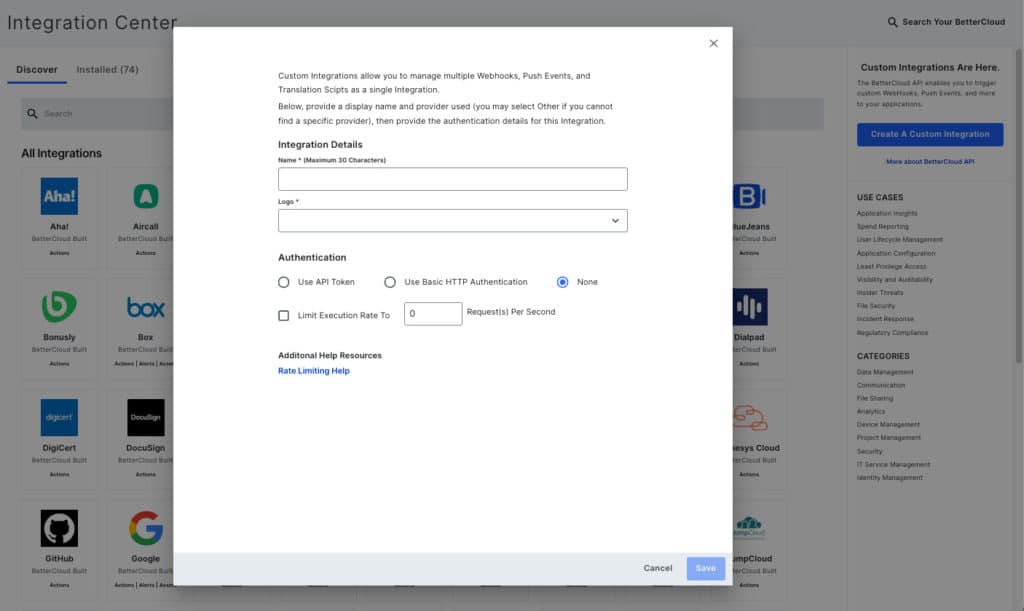The Best of Both Worlds: How BetterCloud’s No-Code Automation Offers Low-Code Extensibility
December 9, 2021
4 minute read

The average IT environment now includes 110 SaaS applications—an already large number that just keeps growing every year. Managing all these apps is requiring more and more work, yet IT departments remain lean and overburdened. To make the most of their staff’s time (and not work 12 hour days themselves), IT leaders are seeking ways to automate the repetitive, tedious tasks involved with managing a large SaaS portfolio.
However, the marketplace of solutions for IT automation is large and complex, and comparing one tool to another is difficult. Many market themselves as no-code, meaning they are built for end users without an extensive coding background. Other automation solutions are low-code, created specifically for developers and other technologists with a deep programming know-how. Both types of platforms can be purpose-built for use by specific departments, such as HR or IT, or serve as “all-purpose” automation engines for citizen developers and other business users.
In this article, we’ll walk through the pros and cons of each when it comes to IT automation. We will also explore how BetterCloud’s no-code workflow engine was built to provide many of the benefits of low-code platforms.
No-code vs low-code: advantages and trade-offs for IT automation
No-code platforms have many advantages for IT automation, largely because they don’t require extensive coding knowledge to set up and manage. No-code tools can be deployed quickly, and existing automated processes can be changed without waiting for a long development cycle. However, some no-code solutions can have significant limitations on functionality, only enabling automation for specific apps or use cases.
On the other hand, solutions built to be low-code offer developers a great deal of choice over what they can automate. Many low-code automation platforms can integrate practically any app with any other. Solutions like these give developers a way to create custom automations for specialized use cases in much less time.
For IT admins looking to automate their day-to-day tasks, however, the price for low-code flexibility can be very high.
In low-code platforms, highly specialized training is often required to automate even the most basic IT processes.
When SaaS apps inevitably update the way they function or offer new features, a low-code automated process will need to be updated, or may even need to be fully rebuilt—adding long wait times and a return to manual work until the update is complete.
The power of no-code automation purpose-built for IT
If an IT department is handling all of its SaaS management tasks manually, any amount of automation will save time and reduce errors. Other IT environments may have automated some tasks with custom scripting—often written by an employee who left years ago or a costly contractor. In order to maintain these processes (let alone automate anything else), IT admins would need to undergo specialized training or hire outside help.
In both of these situations, BetterCloud can empower IT departments to automate much of their day-to-day work without developers or coding know-how.
Out of the box, IT managers can leverage BetterCloud’s 70+ pre-built integrations and customizable workflow templates to automate the most common tasks with the most popular SaaS apps in use today.
That’s not to say BetterCloud doesn’t have a learning curve, but with a streamlined, visual interface and “when-if-then” workflow logic, it is designed to be a gentle one.

In weeks—vs months for many low-code solutions—the vast majority of BetterCloud customers have deployed multiple automated workflows from pre-built templates for onboarding, offboarding, file security, and more. As SaaS management needs expand, new automated actions can be easily added to continually increase IT efficiency and employee productivity.
A no-code solution with low-code extensibility
BetterCloud’s no-code workflow engine offers a quick way to start automating tasks with the most heavily adopted SaaS applications out there—Google Workspace, Office 365, Okta, Zoom, Slack, and more. As a SaaS management platform, BetterCloud was also designed to be flexible enough to extend into the thousands of SaaS apps on the market today.
To offer the deep level of customization many low-code solutions provide, BetterCloud’s Integration Center allows users to build new integrations and actions using the platform API.
Motivated IT admins can learn everything they need to know to become a BetterCloud developer in our on-demand API course. For in-depth questions and more challenging use cases, the BetterCloud’s Customer Engineering team is available for consultation.
From kicking off automated onboarding from an HRIS to automatically adding users to an application when they submit a ticket, BetterCloud’s extensibility helps IT departments get closer to realizing their zero-touch automation goals. If a company relies on a specialized SaaS app to keep employees productive, an entirely new integration can be built to automate its management tasks.

BetterCloud’s native integrations can also be extended to add new actions into the core workflow engine. For example, if a company uses LeanKit, BetterCloud’s integration can be customized to manage user access to individual kanban boards. Then, workflows can be built or modified to automatically add new hires to a specific board based on their department, or change the board a user has access to if they take on a new role.
Because it was purpose built for IT and SaaS management, BetterCloud enables users to deploy no-code IT automation quickly, without a time-consuming learning curve or scripting knowledge. BetterCloud also provides the extensibility and flexibility of low-code platforms, enabling you to add new actions and integrations with more of the SaaS apps in your company’s current (and future) portfolio.
To learn more about BetterCloud’s API, you can visit the BetterCloud developer portal.






